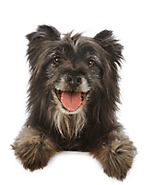Are you having a hard time choosing the right dog harness, leash and/or collar for your fur baby? You know, it’s super important to have done proper research before deciding which of the three to purchase. They all contribute a great deal to your pup’s well-being and happiness.
It can be just as overwhelming as standing in the cereal section at a grocery store, however, there are too many options to choose from!
Whether your pooch is a puller on the leash or super well-behaved, we’re going to break down the things to pay attention to in your research and the pros and cons of each piece of walking equipment to make the decision a little easier for you.
Collars
You can easily get confused between a collar and a harness, or at least while choosing from the different options available— flat collar, head collar, prong collar, martingale collar, etc.
In general, getting the right collar means making the walk more secure and delightful for both you and your dog. Each equipment piece serves a different purpose; nevertheless, it’s important to equip your pup with one that’s just right for them.
This is the most widely used collar. It is simple and effective in achieving its purpose— to attach a leash and ID tag. All dog parents know about it!
Pros: It’s easy to use and gentle on your dog’s neck (if not pulled with leash).
Cons: Your dog can get choked if pulled with leash.
To learn the proper use of this collar, you can watch our tutorial video here.
Similar to a horse-halter, it goes over your dog’s nose and straps behind his/her ears. This enables you to control your dog very well and prevents pulling from occurring. No wonder it is also known as a gentle leader!
Pros: It helps prevent the worst kind of pulling; it calms your dog down and gives you a greater sense of being in control. The communication between you and your pup is strengthened and very clear.
Cons: Some dogs might not like to wear it and might scratch at their noses once it’s on as a sign of discomfort. If your dog is not pleased with the Gentle Leader, please assess properly (adjust tightness, research into other no-pull harness options, etc.).
For properly equipping this collar/harness, watch our video tutorial here
This collar is mostly used by vets and shelter offices to control untrained dogs for safety purposes. Owners also use this one during dog shows, to keep the best kind of control over their fur babies as they’re showing off their tricks and talents!
Pros: Can help control strong and untrained dogs.
Cons: Harms the dog if they lunge frequently.
This one is a combination of a flat collar and a slip collar. It works like a pulley system!
Pros: Your dog will not slip out of this collar. It prevents neck injuries and choking for the most part. It’s also a great option for breeds like Greyhounds because they have smaller heads in comparison to their necks.
Cons: It typically does not have a place to hold ID tags. There is no limit as to how much the collar can tighten; so if a dog is pulling very hard in an opposite direction from which you’re pulling, the collar will tighten a lot and thus cause some choking.
This type of collar is very controversial and is not recommended. Although it can be used for self-corrections, we at Hands N Paws don’t support its usage at all. Pulling a dog by the pinch collar can cause much pain to your dog’s neck and if anything might scare them from wanting to do their favorite activity- go on walks.
Pros: Has potential to correct lunging.
Cons: It can be seen as very inhumane.
These collars are used to train dogs by giving them an electric shock when they go out of the premises of where they’re permitted, or if they do something unwanted such as excessive barking. Modern shock collars have adjustable shock levels. It is mainly for invisible fence use. The team at Hands N Paws does not always support the use of Shock Collars, but understands where they may be necessary for a dog parent to use/invest in.
Pros: It’s much easier and cheaper to purchase a shock collar (along with an invisible fence) than to get an actual fence installed at your house. This is a main reason why dog parents invest in shock collars- to train their dog to know boundaries in regards to poor behaviors as well as physical boundaries in yarded/dog areas.
Cons: The shocks can make the dog fearful, which can then lead to something called “overcorrection.” This happens when the dog begins to see every behavior as potentially a misbehavior that will get punished. With this, the dog’s learning occurs on the basis of fear.
Harnesses
Have a dog who uncontrollably pulls or lunges on walks, or are you a dog parent who just wants to “play it safe” when it comes to your dog’s neck? Consider investing in a harness! We at Hands N Paws fully support the use of harnesses since they seem to be super effective in the benefits they have to offer. Read on as to why!
This is the most basic and most popular kind of dog harness. Most dogs feel comfortable in it. You should note that it does not necessarily teach your dog to not pull. A dog who is pulling already will still pull while wearing it.
Pros: Trained dogs feel more natural and less uncomfortable with a back-clip simply because there’s no pulling on the neck involved. Also, the leash does not get tangled in between the dog’s legs (because it is attached to D-rings on the dog’s backside!).
Cons: Does little help in teaching a dog to walk properly without pulling. It could cause pulling to worsen simply because the back-end resistance is going to make the dog want to naturally pull in the opposite direction.
Have a look at our tutorial video for how to properly equip this harness on your dog.
This harness mainly helps with leash pulling. With this harness, you can easily turn your dog away from something else and towards you through strong communication. We fully support the use of front-clip harnesses!
Pros: Helps you to easily steer your dog if he tries to pull, simply because the leash will pull his front end back and towards you. This pivoting communicates wonders to your dog, because it causes his entire front-end to be moved towards you, and thus the forward-pulling to be discouraged.
Cons: Your dog can still pull with this harness (that’s when we’d recommend utilizing the Gentle Leader on your pup, as mentioned above!).
Have a look at our tutorial video for how to properly equip this harness on your dog.
Leashes
By now you probably have decided which type of collar or harness is safe and most suitable for your dog. But, you cannot only use a collar or harness to tame or walk your dog. Rather, you also need to have the proper leash to make sure your buddy is joyful and well-behaved.
Leashes are also available in different types like flat lead, retractable lead, rope dog leash, etc.
This is the “staple” and most popular dog leash, which measures about 4-8 feet in length. It is simple and easy to use as well as quite safe. It clips onto the thickest ring on the dog’s collar and/or harness and that’s all.
Pros: They are cheap, simple, and effective. Provides for great control over your dog.
Cons: They can harm your dog’s neck if attached to only a collar. That’s why we suggest attaching to a harness!
These leashes are used for teaching recalls, but also for giving a dog some freedom to roam on his/her walk. We at Hands N Paws don’t necessarily recommend them; however, if you want to use a retractable lead for your dog, you should follow the rules of thumb- beware of your surroundings and don’t allow too much freedom to the point where you lose control over your pup!
Pros: Gives your dog more space to move around on walks. The leash lengthens and shortens based on where your dog goes.
Cons: You have almost no ability to control your dog if the leash is extended out too far. Especially if a dog is highly reactive to moving things, people, cars, etc. you will find it difficult and impossible to gain control over your dog that’s freely way ahead of you It can also cause burns if you instinctively grab the moving lead (to gain control) in the case that your dog goes running out in front of you quickly.
These leashes are comparatively more durable and easier to grip, being made of the same material used to make mountain climbing ropes.
Pros: The quality is great, tear-proof, and gives you good control over your dog (in the same way that a flat lead does).
Cons: They are usually heavier (which is not suitable for smaller dogs) and somewhat awkward to hold/grip.
How We Use The Equipment
Dog walkers at Hands N Paws are trained to use each of the various leashes, harnesses, and collars mentioned above. Even when it comes down to holding certain leashes properly and rules of thumb for fitting harnesses on clients’ dogs, we don’t come up short!
Our highly trained dog walkers follow the “two-finger rule” when it comes to harness-fitting. This rule says that there should be a gap of two fingers between the equipment and the dog’s skin once the harness is on the dog. Any more than that is too loose and any less than that is too tight, and thus needs to be adjusted.
We also have a certain way of holding a flat lead leash, known as the “finger-lock method.” This method is best-suited for proper control on walks and also enables us to use the leash as the communication tool it’s intended to be.
We want our clients’ dogs to be healthier and happier, and we advocate for leaving situations better than they’re found. So, we only make suggestions about which equipment is the best for each dog after a thorough and individualized examination and/or whenever we notice something is “off” and can be fixed. For example, if we’re working with a dog whose got a back-clip harness, but seems to be a huge puller on walks, we definitely bring it to the owner’s attention and suggest getting a front-clip harness for the dog’s well-being and behavior correction.
Happy Dog = Happy Dog Parent
Now that you have an understanding of the various collars, harnesses, and leashes, you can make an informed decision on which to invest in for your pup based on his/her personality, behaviors, and needs. Feel free to reach out to our team for questions not answered within this article. We are professionals and so it is part of our mission to make you a happy and content pup parent!














